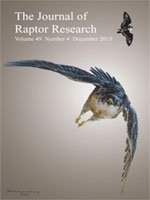Long-term monitoring programs that can detect a population change over time can be useful for managers interested in assessing population trends in response to forest management activities for a particular species. Such long-term monitoring programs have been designed for the Northern Goshawk (Accipiter gentilis), but not for the more elusive Sharp-shinned (A. striatus) and Cooper's hawks (A. cooperii). The objectives of this study were to (1) determine if it was possible to survey for these two Accipiters at the same time successfully using a new survey technique, and (2) estimate occupancy rate and detection probabilities for both species. We used broadcast surveys (BSM) to determine presence/absence for nesting Sharp-shinned and Cooper's hawks at Mountain Home Demonstration State Forest located in the southern Sierra Nevada mountain range in California. We surveyed 34 sampling units that were defined as the average home-range size (1000 m2) of the smallest target species, the Sharp-shinned Hawk. The sampling units were surveyed twice in 2003 and 3–4 times in 2004 during the breeding season. We used program PRESENCE to estimate detection probabilities and model occupancy rates for Sharp-shinned and Cooper's hawks. Our results indicated that the BSM using both Accipiter vocalizations in sequence was valuable for surveying both Sharp-shinned and Cooper's hawks. Proportions of the study area occupied for Sharp-shinned and Cooper's hawks were 0.25 (SE = 0.079), and 0.40 (SE = 0.098), respectively. The probabilities of detecting Cooper's and Sharp-shinned hawks at any given site were 0.56 (SE = 0.098) and 0.47 (SE = 0.086), respectively. There were no published occupancy estimates or detection probabilities in the literature to directly compare to our study. Because these species are elusive and difficult to survey, it is imperative future studies that address occupancy estimation for Sharp-shinned and Cooper's hawk incorporate detection probabilities into their model. Incorporating other variables into an occupancy model, such as habitat type, timber harvest, forest health, and/or climatic variables will also improve occupancy estimates.
How to translate text using browser tools
1 December 2015
Estimating Site Occupancy and Detection Probabilities for Cooper's and Sharp-Shinned Hawks in the Southern Sierra Nevada
Jennifer E. Carlson
ACCESS THE FULL ARTICLE

Journal of Raptor Research
Vol. 49 • No. 4
December 2015
Vol. 49 • No. 4
December 2015
Accipiter cooperii
Accipiter striatus
Cooper's Hawk
detection probability
long-term monitoring
Sharp-shinned Hawk
site occupancy




